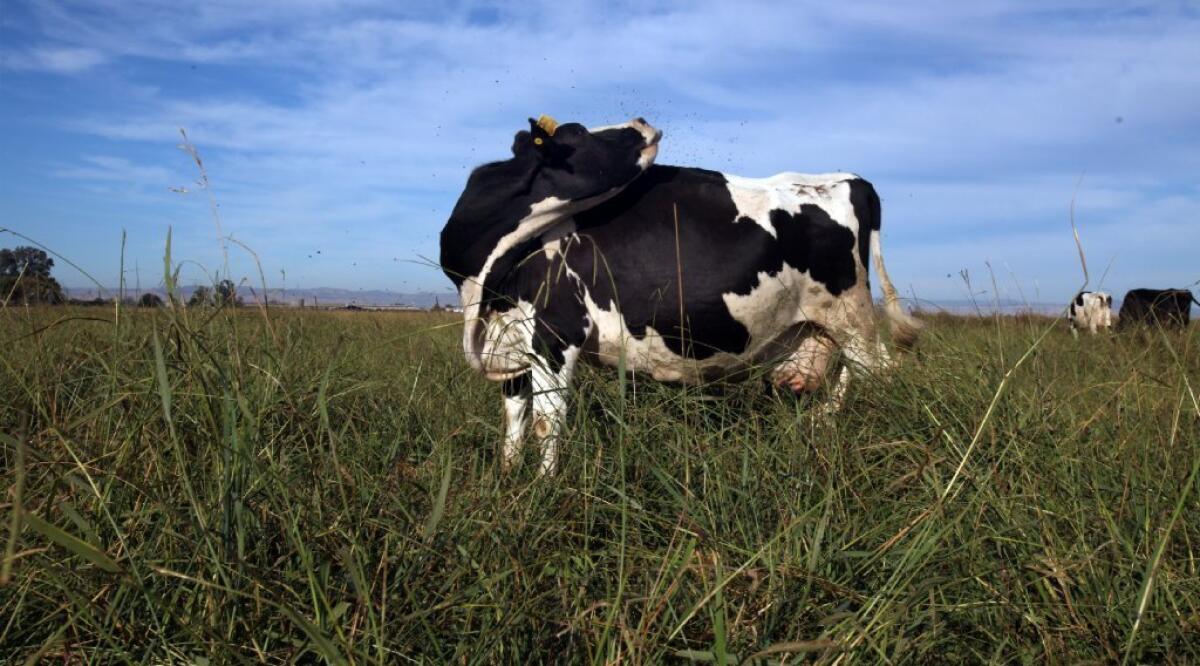Organic whole milk provides best heart-health benefits, study says

- Share via
Scientists who looked at hundreds of samples found that organic whole milk offered more of the fatty acids good for the heart than conventional milk.
“We were quite surprised to see the magnitude of difference in milk from organic farms,” said Charles Benbrook, lead author of the study and a program leader at the Center for Sustaining Agriculture and Natural Resources at Washington State University.
Organic food advocates argue that grass and pasture is healthiest feed for cows. Federal organic standards require that cows get at least 30% of their dry food from pasture at least 120 days of the year. Benbrook’s study is the first large-scale nationwide study of the fatty acids in organic and conventional milk. Cows on conventionally managed farms get more grains such as corn.
The study results, published Monday in the journal PLOS One, also question the common recommendations to consume nonfat or low-fat dairy products. Whole milk is around 4% fat, with 2%, 1% and skim being other choices. Skim milk does not have fatty acids.
“Consumers are going to get the full measure of this benefit in organic milk if they buy whole milk,” Benbrook said.
The study, Benbrook said, “provides consumers with some pretty powerful evidence that choosing full-fat dairy products is going to help bring about a greater degree of balance” between omega-3 and omega-6 fatty acids and help reduce the risk of heart disease and several other problems.
The broader message, he said, is that people need to pay attention to the type of fat as well as to the overall amount of fat they consume.
Over the last 100 years, Western diets have grown to contain more omega-6 fatty acids and fewer omega-3 fatty acids. The ratio should be flipped, the authors say.
The conventional milk had an average omega-6 to omega-3 fatty acid ratio of 5.8, and organic milk had a ratio of 2.3.
The scientists looked at 220 organic milk samples from the Organic Valley cooperative and 164 conventional milk samples. Organic Valley was a funder of the study.
The study found that the organic milk had 25% less omega-6 fatty acids and 62% more omega-3 fatty acids than conventional milk. The organic milk also had high concentrations of the individual types of omega-3 fatty acids, too, the authors wrote.
“There is increasing evidence that the dietary balance of omega-3 and omega-6 fatty acids is perhaps as important as the dietary proportions of saturated, monounsaturated and total fat,” the authors wrote.
Over the last few decades, people have increased how much soybean and corn oil and fried foods they have eaten, Benbrook said. Those foods have increased the number of calories eaten overall and driven up the ratio of omega-6 fatty acids to omega-3 fatty acids, he said.
Overall, Benbrook said, this is not just good news for organic dairy farmers.
“Our study has good news for all dairy farmers and all people who like diary products,” he said. “Milk is one of the healthiest sources of fat in the diet. But we can conclude that organic milk is healthier.”
ALSO:
Regular bedtimes good for kids
Mary.MacVean@latimes.com



